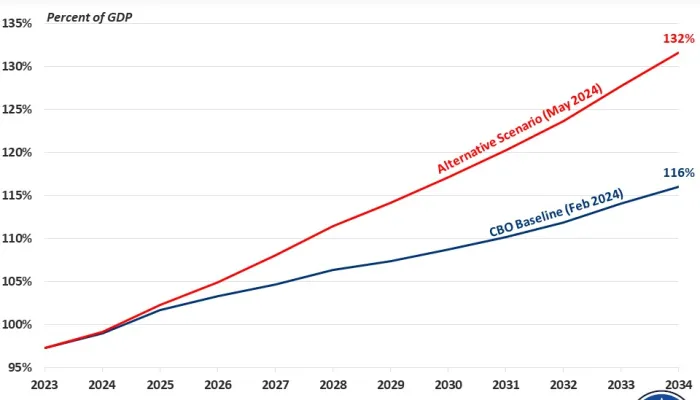How the FY 2018 Budget Could Avoid a Conference
The Senate Fiscal Year (FY) 2018 budget resolution passed last night on a 51-49 vote. The budget included a "technical" amendment by Senate Budget Committee Chairman Mike Enzi (R-WY) that added several provisions on reconciliation, discretionary spending, and budget enforcement as they pertain to the House of Representatives.
According to press reports, the amendment's purpose was to modify the Senate budget so the House could pass it as-is and avoid a conference committee to work out differences.
The amendment did not change the big picture aspects of the budget (summarized here): the budget still reduces deficits on paper without reaching unified balance, but it would allow lawmakers to add to deficits in practice by allowing $1.5 trillion in deficit-financed tax cuts and only requiring nominal spending reductions of $1 billion.
In contrast, the House budget would balance on paper after a decade, calls for tax reform that does not add to debt, and includes mandatory savings of at least $200 billion. The Senate budget is far less responsible than the House budget, and accepting the Senate budget would be a large step towards irresponsibility.
The most important part of the amendment is a change to the House's reconciliation instructions. The unamended Senate budget had included House reconciliation instructions for a "no more than" $1.5 trillion deficit increase from the Ways and Means Committee and at least $1 billion of savings from the Natural Resources Committee to mirror instructions given to Senate committees. Both House committees were required to report bills to the House Budget Committee by November 13, a non-binding deadline.
The new instructions only include the $1.5 trillion deficit increase to House Ways and Means, removing the savings instruction to the House Natural Resources Committee. Even without these instructions, the House could consider a Senate-passed reconciliation bill or conference report with energy provisions because the Senate Energy Committee still has savings instructions.
Because the House reconciliation instructions are only to one committee, a bill could go right to the House floor without going through the Budget Committee. (See our Reconciliation 101 flowchart for more.) Removing savings instructions to the Natural Resources Committee provides a slightly quicker path for the House to pass the tax reform reconciliation bill.
Another relevant part of the amendment relates to defense, making it slightly easier to increase spending in the event of a bipartisan deal that changes the discretionary spending caps. The amendment allows the House Budget Committee Chairman to adjust numbers in the budget to allow an increase in the FY 2018 defense spending allocation to $640 billion, $91 billion higher than the allowed amount under current law and $18 billion higher than the House's budget resolution. This provision does not require offsets, and statutory pay-as-you-go (PAYGO) rules that prohibit mandatory spending increases and revenue decreases (without offsets) would not apply here since it is a discretionary spending change.
Both of these provisions smooth the path to deficit increases, even if neither directly creates a tax cut or defense spending increase.
Other minor parts of the amendment add budget enforcement provisions relevant to the House. Many of them limit budget gimmicks. Highlights include:
- A point of order in the House against bills that increase spending by at least $2.5 billion in any of the four decades following the first decade. This is slightly more stringent than the current point of order that applies to bills that increase spending by $5 billion in any of the three decades following the first.
- A point of order in the House that limits fake savings from changes in mandatory programs (CHIMPs) to $19.1 billion in FY 2018, $17 billion in FY 2019, and $15 billion in FY 2020. These numbers are slightly less strict than the Senate's restriction.
- Continuing the requirement that the Congressional Budget Office (CBO) evaluate the macroeconomic effects of House legislation that has a budgetary effect of at least 0.25 percent of Gross Domestic Product (in other words, requiring dynamic scoring).
- Creating a new requirement for CBO to calculate the debt service costs of a bill to be used in an advisory capacity.
- Requiring CBO to calculate a fair-value baseline for credit programs and calculate fair-value as part of score of a bill involving credit programs and student loans.
- Counting general fund transfers to the Highway Trust Fund as a cost.
- Prohibiting the use of Federal Reserve surpluses or Fannie Mae/Freddie Mac guarantee fees as offsets.
- Including House reserve funds for air traffic control privatization, infrastructure investment, tax reform, and health care reform.
Ultimately, the central purpose of the Enzi amendment was to fast-track the budget resolution to avoid a conference and bring Congress closer to passing a $1.5 trillion tax cut. Instead of adding a large amount to an already unsustainable debt, lawmakers should work to ensure that tax reform at the very least doesn't add to deficits. They could start by keeping the House budget's target of revenue-neutral tax reform.

